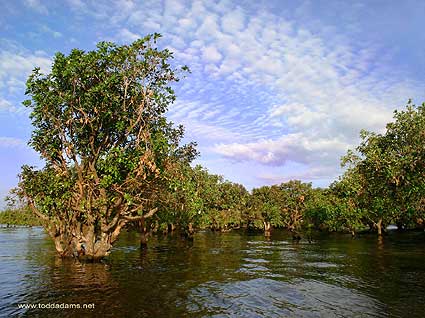Silent saviour: The mangrove effect
The effect of the tsunami striking East Asia one year ago could have had much less impact - if only the mangrove forest that had been guarding the coast for years, had still been there to protect the coastlines.

photo permission: Todd Adams
Recent reports from India and Indonesia demonstrate that in coastal areas with a healthy mangrove forest, the force of the tsunami was relatively slight. On the other hand, where the trees had been cut to provide space for shrimp farms and the tourism industry, the effect was devastating. Research shows that a giant wave, such as the one from the Asian Tsunami, may lose as much as 20% of its energy for every 100 meters of mangrove through which it passes, and that an entire forest can absorb between 70 and 90% of these destructive wave’s energy. View an interactive satellite photo map of Tsunami affected areas in the Indian Ocean at Greener Maps.
Following the catastrophe on December 26, 2004, the World Conservation Union (ICUN) compared two similarly situated villages located in Sri Lanka, also struck by the wave. The result was shocking, in these villages where mangroves were uprooted 6000 people had died, compared to just two deaths where the mangrove forest still grew at the shoreline. To the 60,000 inhabitants in Indonesia’s Pulau Simeulue, the "mangrove effect” limited the deaths to just one hundred. In other nearby places with comparable population numbers, tens of thousands perished. Ngapattinam, situated in south India, which was one of the hardest hit areas also had the most mangrove areas cleared for *prawn farms production. In Thailand, there came reports that areas, where the forest had been removed in favour of tourist settlements, the tsunami damage was severe; one such place is Phi-Phi Island. (see Map)
At the Mangrove Action Plan (MAP) website, John Gray, a guide from Phuket, Indonesia who witnessed the tsunami says, “Phi-Phi Island is a National Park. By law, there are no permanent structures allowed in a National Park.” Now, one year later, Gray notes, “extensive reconstruction of hotels and restaurants is well underway at the very same shoreline sites.”
Today more than half of the world’s mangrove forest is lost to unfettered economic growth. In addition, the protecting coral reefs and sea grass beds are being increasingly threatened. These "coastal greenbelts of protection" play a vital role not just by protecting shorelines from catastrophic flooding whether from tsunamis or hurricane driven sea surge, but also by reducing sedimentation and shoreline erosion. Mangroves provide shelter for marine life which in turn stimulates a more productive fishing industry, In fact, these mangrove shelters provide a rich source of many other commodities including medicines, fruit, honey, lumber, fuel wood, tannins and they’re aesthetically beautiful.
Prior to the tsunami authorities had speculated about the risks involved in exploiting the mangrove forests by clear cutting to produce commercial shrimp farms, however these discussions were ultimately ignored in favour of development and profit. The lesson is unmistakable, if there had been less demand for tiger-shrimp and beach hotels likely the mangroves would have been left untouched and the scale of the tsunami disaster most certainly could have been lessened.
However, change may be on its way. In the south Indian state of Kerala, the government recently initiated a one million dollar project to plant new mangrove forests along the coasts; and there are similar plans proposed by other organisations, communities and NGOs (non-government organizations)intended to establish a sustainable system of flood mitigation throughout the coastal areas of the Indian Ocean. Some of these proposals prohibit building human settlements outright while others limit fixed enterprises for tourism or aquaculture in inter-tidal zones, including mangroves, mudflats, salt flats and marshes. In the end, perhaps the real tsunami-effect will be that the mangrove will again thrive and protect future generations from the death and destruction caused by these unpredictable, re-occurring tsunamis.
by Karin Didring
Greener Magazine
________________________
*Press release:Svenska Naturskyddsföreningen and CDNN
Tsunami photos - Reuters/MSNBC

photo permission: Todd Adams
Recent reports from India and Indonesia demonstrate that in coastal areas with a healthy mangrove forest, the force of the tsunami was relatively slight. On the other hand, where the trees had been cut to provide space for shrimp farms and the tourism industry, the effect was devastating. Research shows that a giant wave, such as the one from the Asian Tsunami, may lose as much as 20% of its energy for every 100 meters of mangrove through which it passes, and that an entire forest can absorb between 70 and 90% of these destructive wave’s energy. View an interactive satellite photo map of Tsunami affected areas in the Indian Ocean at Greener Maps.
Following the catastrophe on December 26, 2004, the World Conservation Union (ICUN) compared two similarly situated villages located in Sri Lanka, also struck by the wave. The result was shocking, in these villages where mangroves were uprooted 6000 people had died, compared to just two deaths where the mangrove forest still grew at the shoreline. To the 60,000 inhabitants in Indonesia’s Pulau Simeulue, the "mangrove effect” limited the deaths to just one hundred. In other nearby places with comparable population numbers, tens of thousands perished. Ngapattinam, situated in south India, which was one of the hardest hit areas also had the most mangrove areas cleared for *prawn farms production. In Thailand, there came reports that areas, where the forest had been removed in favour of tourist settlements, the tsunami damage was severe; one such place is Phi-Phi Island. (see Map)
At the Mangrove Action Plan (MAP) website, John Gray, a guide from Phuket, Indonesia who witnessed the tsunami says, “Phi-Phi Island is a National Park. By law, there are no permanent structures allowed in a National Park.” Now, one year later, Gray notes, “extensive reconstruction of hotels and restaurants is well underway at the very same shoreline sites.”
Today more than half of the world’s mangrove forest is lost to unfettered economic growth. In addition, the protecting coral reefs and sea grass beds are being increasingly threatened. These "coastal greenbelts of protection" play a vital role not just by protecting shorelines from catastrophic flooding whether from tsunamis or hurricane driven sea surge, but also by reducing sedimentation and shoreline erosion. Mangroves provide shelter for marine life which in turn stimulates a more productive fishing industry, In fact, these mangrove shelters provide a rich source of many other commodities including medicines, fruit, honey, lumber, fuel wood, tannins and they’re aesthetically beautiful.
Prior to the tsunami authorities had speculated about the risks involved in exploiting the mangrove forests by clear cutting to produce commercial shrimp farms, however these discussions were ultimately ignored in favour of development and profit. The lesson is unmistakable, if there had been less demand for tiger-shrimp and beach hotels likely the mangroves would have been left untouched and the scale of the tsunami disaster most certainly could have been lessened.
However, change may be on its way. In the south Indian state of Kerala, the government recently initiated a one million dollar project to plant new mangrove forests along the coasts; and there are similar plans proposed by other organisations, communities and NGOs (non-government organizations)intended to establish a sustainable system of flood mitigation throughout the coastal areas of the Indian Ocean. Some of these proposals prohibit building human settlements outright while others limit fixed enterprises for tourism or aquaculture in inter-tidal zones, including mangroves, mudflats, salt flats and marshes. In the end, perhaps the real tsunami-effect will be that the mangrove will again thrive and protect future generations from the death and destruction caused by these unpredictable, re-occurring tsunamis.
by Karin Didring
Greener Magazine
________________________
*Press release:Svenska Naturskyddsföreningen and CDNN
Tsunami photos - Reuters/MSNBC



2:50 PM









<< Home